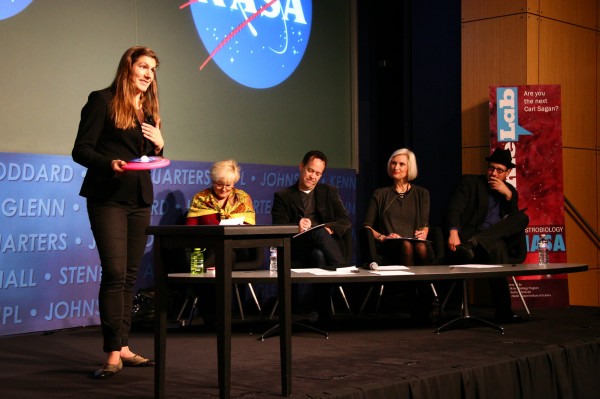15 March 2012
Three minutes to be like Sagan: Competition seeks short bits on science
Posted by mcadams

Julia DeMarines, of the Denver Museum of Nature & Science, uses a Frisbee as a model of the Milky Way to show where planets supporting life might be expected to form within a galaxy. Photo by Mary Catherine Adams, AGU.
Prove you’re the next Carl Sagan in three minutes or less. Now, go! That’s what young scientists, engineers and aspiring PhDs in the United States are being called to do – move an audience the way Sagan could, but in three minutes or less. Friday morning, a group of young speakers gathered at NASA headquarters in Washington, D.C., to give it a try.
Standing on a stage in front of four judges and facing an audience, twenty-four competitors responded to the challenge of making a complex scientific subject – like advanced mathematic equations and RNA analysis – tangible to a broad audience. On either side of the stage, tall posters asked “Are you the next Carl Sagan?” No pressure.
The communication competition – a bit like mini, all-science TEDTalks – is called FameLab Astrobiology and is part of a larger, international competition called FameLab. In the U.S., NASA and several other organizations host an astrobiology-themed competition to select a speaker to move on to the international finals, where any scientific topic is game. Each competitor prepares two three-minute speeches about any astrobiology topic, one for the morning heat and a second for the evening heat to be used if they make the cut. Props are the only acceptable visual aids, and competitors cannot use slides, video, charts, printed images, or any other kind of electronic media. “NO powerpoint allowed!” shouts a banner on the FameLab Astrobiology web site.
With his three minutes, Joshua Stern, a graduate student of synthetic biology at the Georgia Institute of Technology in Atlanta, used the analogy of packing the family van before a vacation to explain Monte Carlo simulations – computer-based ways of solving problems. Dad could sit down with paper and pen to find the best arrangement, working out each of many ways the suitcases could be turned and stacked like life-size Tetris pieces. Or he could stand behind the car and use trial-and-error. Trial-and-error, Stern said, was the way to go. Forgoing complicated systems of equations in favor of a little elbow grease is a lot like a Monte Carlo simulation: Try one method and use what did or did not work to improve the next attempt. Rearrange the suitcases a couple of times until you get the best fit.
“Life,” Stern said in the last few seconds of his talk, “is like a 3.8 billion year Monte Carlo simulation.”
It was hard preparing for the short speech, Stern said, but tips from an undergraduate theater class helped him with memorization. “The speech shouldn’t sound memorized but it still needs to be remembered,” he said. “That’s the really tricky part – remembering it and being able to improvise on the delivery.”
While Stern relied on his energy and the visual of a family cramming luggage into a 2001 Chrysler minivan for his talk, other speakers included props. Julia DeMarines, assistant to the curator of astrobiology at the Denver Museum of Nature & Science, used a Frisbee as a model of the Milky Way Galaxy. Pointing to the center of the Frisbee, DeMarines explained that stars at the center of a galaxy are clustered too closely, causing too much chaos, to support life. At the edges, she said while touching the rim of the flying disc, there is too little interaction to sustain life. The region in between is where scientists expect life to exist, in an area called the galactic habitable zone.
Becky McCauley, a PhD candidate studying astrobiology at Pennsylvania State University, used a skewer and a small ball to illustrate how the movement of the Earth’s axis – the imaginary line running through our planet’s core – affects climate and causes seasons.
Walking out on stage with the skewer in her hair, McCauley drew it out during her talk, threading the sphere onto the stick as she introduced the term “axis.” Though the judges applauded her for having a great prop, they cautioned that the long stick protruding from her head when she first walked on stage was too distracting. You could have the greatest sportscaster of the century on TV, said judge Bill Margol with National Geographic Television, but if his tie is crooked that is all people will see.
After communications training in the afternoon, the judges announced the ten finalists who would compete in the evening heat at the National Geographic Society headquarters in downtown Washington, D.C. There, one overall winner, Noah Hammond, a research assistant with the Carl Sagan Center at the SETI Institute in Mountain View, Calif., was selected to move on to the national competition at the Astrobiology Science Conference (AbSciCon) in Atlanta this April.
Three more overall winners will come from two additional regional competitions and an online competition held on YouTube. Six additional “wild card” competitors from the preliminary competitions will join them. Of those ten competing in Atlanta, one will be chosen as the national winner and will compete against competitors from 20 other countries at the FameLab International final in the United Kingdom this June.
By Mary Catherine Adams, AGU Public Information Specialist










 The Plainspoken Scientist is the science communication blog of AGU’s Sharing Science program. With this blog, we wish to showcase creative and effective science communication via multiple mediums and modes.
The Plainspoken Scientist is the science communication blog of AGU’s Sharing Science program. With this blog, we wish to showcase creative and effective science communication via multiple mediums and modes.